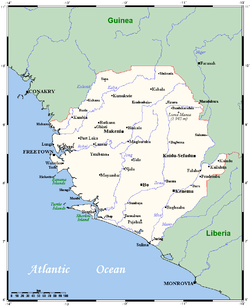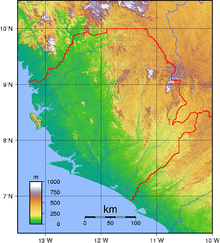- Geography of Sierra Leone
-
Geography of Sierra Leone 
Continent Africa Region Western Africa Coordinates 8°30′N 11°30′W / 8.5°N 11.5°W Area Ranked 119th
71,740 km2 (27,700 sq mi)Borders Guinea, Liberia Highest point Mount Bintumani
1,948 m (6,391 ft)Sierra Leone is located on the west coast of Africa, between the 7th and 10th parallels north of the equator. Sierra Leone is bordered by Guinea to the north and northeast, Liberia to the south and southeast, and the Atlantic Ocean to the west.[1] The country has a total area of 71,740 km2 (27,699 sq mi), divided into a land area of 71,620 km2 (27,653 sq mi) and water of 120 km2 (46 sq mi).[2] The country has four distinct geographical regions: coastal Guinean mangroves, the wooded hill country, an upland plateau, and the eastern mountains. Eastern Sierra Leone is an interior region of large plateaus interspersed with high mountains, where Mount Bintumani rises to 1,948 meters (6,391 ft).[1]
Contents
Physical geography
Sierra Leone is located on the west coast of Africa, between the 7th and 10th parallels north of the equator. Sierra Leone is bordered by Guinea to the north and northeast, Liberia to the south and southeast, and the Atlantic Ocean to the west.[1] The country has a total area of 71,740 km2 (27,699 sq mi), divided into a land area of 71,620 km2 (27,653 sq mi) and water of 120 km2 (46 sq mi).[2] The country has four distinct geographical regions: coastal Guinean mangroves, the wooded hill country, an upland plateau, and the eastern mountains. Eastern Sierra Leone is an interior region of large plateaus interspersed with high mountains, where Mount Bintumani rises to 1,948 meters (6,391 ft).[1]
Geology
Sierra Leone can be split into three geological areas, in the east is part of the West African craton, the western area consists is the Rokelides, an orogenic belt, and a 20 to 30 km coastal strip of sediments.[3]
Extreme points
This is a list of the extreme points of Sierra Leone, the points that are farther north, south, east or west than any other location.
- Northern-most point – the northern section of the border with Guinea, Northern Province*
- Eastern-most point – the tripoint with Guinea and Liberia, Eastern Province
- Southern-most point – unnamed peninsula south of the town of Mano Salija at the mouth of the Mano River, Southern Province
- Western-most point - the point at which the border with Guinea enters the Atlantic Ocean, Northern Province
- *Note: Sierra Leone does not have a northern-most point, the border being formed here by 10th parallel north
Climate
The climate is tropical, although it could be classified as a tropical monsoon climate it could also be describe as a climate that is transitional between a continually wey tropical rainforest climate and a tropical savanna climate.[4] There are two seasons determining the agricultural cycle: the rainy season from May to November, and a dry season from December to May, which includes harmattan, when cool, dry winds blow in off the Sahara Desert and the night-time temperature can be as low as 16 °C (60.8 °F). The average temperature is 26 °C (78.8 °F) and varies from around 26 °C (78.8 °F) to 36 °C (96.8 °F) during the year.[2][5][6] Average rainfall is highest at the coast, 3000-5000 mm per year, moving inland this decreases and at the eastern border of the country the average rainfall is 2000-2500mm.[7]
Environmental agreements
Sierra Leone is party to several environmental agreements:[2]
- Biodiversity (Convention on Biological Diversity)
- Climate Change (United Nations Framework Convention on Climate Change)
- Desertification (United Nations Convention to Combat Desertification)
- Endangered Species (CITES)
- Law of the Sea(UNCLOS or LOS)
- Marine Life Conservation (Convention on Fishing and Conservation of Living Resources of the High Seas)
- Nuclear Test Ban(CTBT)
- Ramsar Convention(Wetlands)
Signed, but not ratified:
- Environmental Modification(ENMOD)

General information
Geographic coordinates: 8°30′N 11°30′W / 8.5°N 11.5°W
Land boundaries:
total: 958 km
border countries: Guinea 652 km, Liberia 306 kmCoastline: 402 km
Maritime claims:
territorial sea: 200 nmi (370.4 km; 230.2 mi).
continental shelf: 200 m depth or to the depth of exploitation.Terrain: coastal belt of mangrove swamps, wooded hill country, upland plateau, mountains in east.
Elevation extremes:
lowest point: Atlantic Ocean 0 m
highest point: Loma Mansa (Bintimani) 1,948 mNatural resources: diamonds, titanium ore, bauxite, iron ore, gold, chromite.
Land use:
arable land: 7%
permanent crops: 1%
permanent pastures: 31%
forests and woodland: 28%
other: 33% (1993 est.)Irrigated land: 290 km²; (1998, 1993 est.)
Natural hazards: dry, sand-laden harmattan winds blow from the Sahara (November to May); dust storms.
Environment issues: rapid population growth pressuring the environment; overharvesting of timber, expansion of cattle grazing and slash and burn agriculture have resulted in deforestation and soil exhaustion; civil war depleting natural resources; overfishing.
See also
References
- ^ a b c d LeVert, Suzanne (2006). Cultures of the World: Sierra Leone. Marshall Cavendish (published 2007). p. 7. ISBN 9780761423348
- ^ a b c d "CIA: The World Factbook: Sierra Leone". https://www.cia.gov/library/publications/the-world-factbook/geos/sl.html.
- ^ Schlüter, Thomas; Martin H. Trauth (2008). Geological atlas of Africa: with notes on stratigraphy, tectonics, economic geology, geohazards, geosites and geoscientific education of each country. Springer. p. 220. ISBN 9783540763246. http://books.google.com/?id=IfvKWpsISTQC&pg=PA220&dq=sierra+leone+Geology#v=onepage&q=sierra%20leone%20Geology&f=false.
- ^ Gabler, Robert E.; James F. Petersen, L. Michael Trapasso, Dorothy Sack (2008). Physical Geography. Cengage Learning. p. 238. ISBN 9780495555063. http://books.google.com/?id=VkVqmi0MO1IC&pg=PA238&dq=sierra+leone+%22tropical+monsoon%22#v=onepage&q=sierra%20leone%20%22tropical%20monsoon%22&f=false.9780495555063}
- ^ Blinker, Linda (September 2006). COUNTRY ENVIRONMENT PROFILE (CEP) SIERRA LEONE. Freetown, Sierra Leone: CONSORTIUM PARSONS BRINCKERHOFF. p. 12. http://www.delsle.ec.europa.eu/en/whatsnew/Docs/Final%20Report%20Country%20Environmental%20Profile%20(CEP)%20SL%2019-OCT-06.pdf. Retrieved 2008-09-25
- ^ LeVert, Suzanne (2006). Cultures of the World: Sierra Leone. Marshall Cavendish (published 2007). pp. 8–9. ISBN 9780761423348
- ^ Hughes, R. H.; J. S. Hughes (1992). A directory of African wetlands. IUCN. p. 435. ISBN 9782880329495. http://books.google.com/?id=VLjafeXa3gMC&pg=PA439&dq=lake+sonfon#v=onepage&q=lake%20sonfon&f=false.
 This article incorporates public domain material from websites or documents of the CIA World Factbook.
This article incorporates public domain material from websites or documents of the CIA World Factbook.
Sovereign
states- Algeria
- Angola
- Benin
- Botswana
- Burkina Faso
- Burundi
- Cameroon
- Cape Verde
- Central African Republic
- Chad
- Comoros
- Democratic Republic of the Congo
- Republic of the Congo
- Côte d'Ivoire (Ivory Coast)
- Djibouti
- Egypt
- Equatorial Guinea
- Eritrea
- Ethiopia
- Gabon
- The Gambia
- Ghana
- Guinea
- Guinea-Bissau
- Kenya
- Lesotho
- Liberia
- Libya
- Madagascar
- Malawi
- Mali
- Mauritania
- Mauritius
- Morocco
- Mozambique
- Namibia
- Niger
- Nigeria
- Rwanda
- São Tomé and Príncipe
- Senegal
- Seychelles
- Sierra Leone
- Somalia
- South Africa
- South Sudan
- Sudan
- Swaziland
- Tanzania
- Togo
- Tunisia
- Uganda
- Zambia
- Zimbabwe
States with limited
recognition- Sahrawi Arab Democratic Republic
- Somaliland
Dependencies and
other territories- Canary Islands / Ceuta / Melilla / Plazas de soberanía (Spain)
- Madeira (Portugal)
- Mayotte / Réunion (France)
- Saint Helena / Ascension Island / Tristan da Cunha (United Kingdom)
- Western Sahara
Climate of Africa Sovereign
states- Algeria
- Angola
- Benin
- Botswana
- Burkina Faso
- Burundi
- Cameroon
- Cape Verde
- Central African Republic
- Chad
- Comoros
- Democratic Republic of the Congo
- Republic of the Congo
- Côte d'Ivoire (Ivory Coast)
- Djibouti
- Egypt
- Equatorial Guinea
- Eritrea
- Ethiopia
- Gabon
- The Gambia
- Ghana
- Guinea
- Guinea-Bissau
- Kenya
- Lesotho
- Liberia
- Libya
- Madagascar
- Malawi
- Mali
- Mauritania
- Mauritius
- Morocco
- Mozambique
- Namibia
- Niger
- Nigeria
- Rwanda
- São Tomé and Príncipe
- Senegal
- Seychelles
- Sierra Leone
- Somalia
- South Africa
- South Sudan
- Sudan
- Swaziland
- Tanzania
- Togo
- Tunisia
- Uganda
- Zambia
- Zimbabwe
States with limited
recognition- Sahrawi Arab Democratic Republic
- Somaliland
Dependencies and
other territories- Canary Islands / Ceuta / Melilla / Plazas de soberanía (Spain)
- Madeira (Portugal)
- Mayotte / Réunion (France)
- Saint Helena / Ascension Island / Tristan da Cunha (United Kingdom)
- Western Sahara
Categories:
Wikimedia Foundation. 2010.


